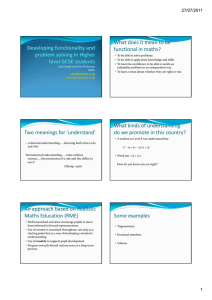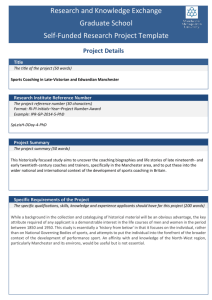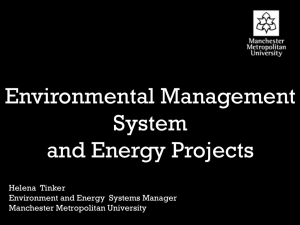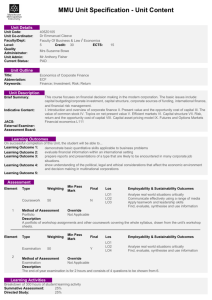The Box-of-chocolate Phenonema: Using Narratives To Improve Staff Morale In Large Organisations
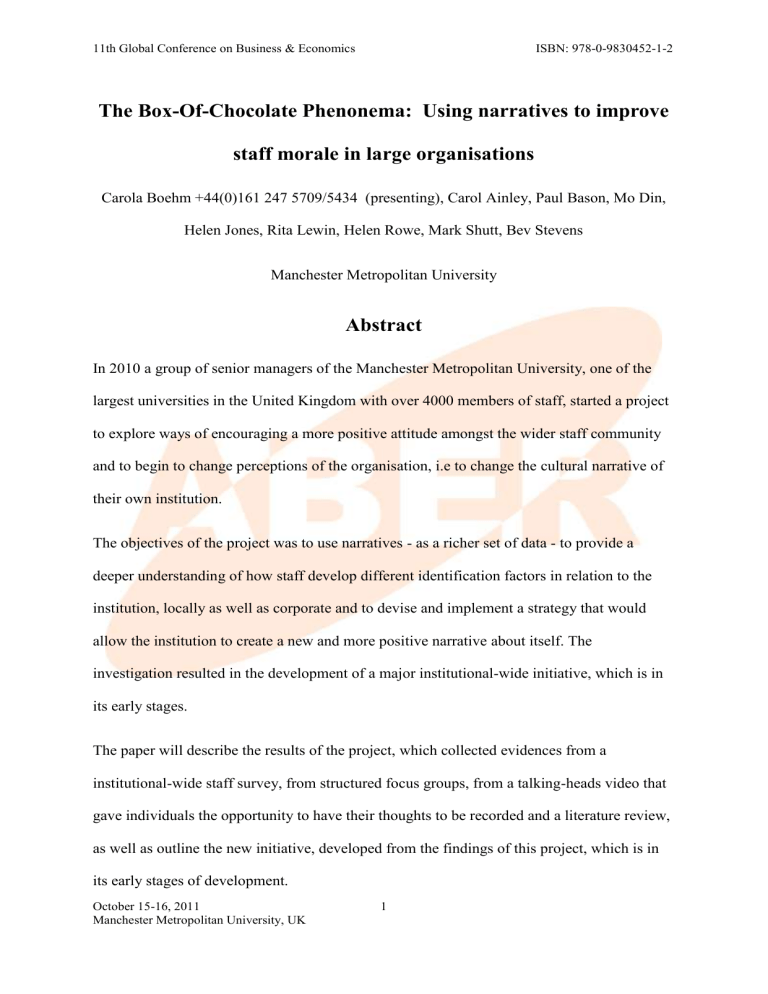
11th Global Conference on Business & Economics ISBN: 978-0-9830452-1-2
The Box-Of-Chocolate Phenonema: Using narratives to improve staff morale in large organisations
Carola Boehm +44(0)161 247 5709/5434 (presenting), Carol Ainley, Paul Bason, Mo Din,
Helen Jones, Rita Lewin, Helen Rowe, Mark Shutt, Bev Stevens
Manchester Metropolitan University
Abstract
In 2010 a group of senior managers of the Manchester Metropolitan University, one of the largest universities in the United Kingdom with over 4000 members of staff, started a project to explore ways of encouraging a more positive attitude amongst the wider staff community and to begin to change perceptions of the organisation, i.e to change the cultural narrative of their own institution.
The objectives of the project was to use narratives - as a richer set of data - to provide a deeper understanding of how staff develop different identification factors in relation to the institution, locally as well as corporate and to devise and implement a strategy that would allow the institution to create a new and more positive narrative about itself. The investigation resulted in the development of a major institutional-wide initiative, which is in its early stages.
The paper will describe the results of the project, which collected evidences from a institutional-wide staff survey, from structured focus groups, from a talking-heads video that gave individuals the opportunity to have their thoughts to be recorded and a literature review, as well as outline the new initiative, developed from the findings of this project, which is in its early stages of development.
October 15-16, 2011
Manchester Metropolitan University, UK
1
11th Global Conference on Business & Economics ISBN: 978-0-9830452-1-2
The Box-Of-Chocolate Phenonema:
Using narratives to improve staff morale in large organisations
Carola Boehm +44(0)161 247 5709/5434 (presenting),
Carol Ainley, Paul Bason, Mo Din, Helen Jones, Rita Lewin, Helen Rowe,
Mark Shutt, Bev Stevens
1
Manchester Metropolitan University
ABSTRACT
In 2010 a group of senior managers of the Manchester Metropolitan University, one of the largest universities in the United Kingdom with over 4000 members of staff, started a project to explore ways of encouraging a more positive attitude amongst the wider staff community and to begin to change perceptions of the organisation, i.e to change the cultural narrative of their own institution.
The objectives of the project was to use narratives - as a richer set of data - to provide a deeper understanding of how staff develop different identification factors in relation to the institution, locally as well as corporate and to devise and implement a strategy that would allow the institution to create a new and more positive narrative about itself. The investigation resulted in the development of a major institutional-wide initiative, which is in its early stages.
The paper will describe the results of the project, which collected evidences from a institutional-wide staff survey, from structured focus groups, from a talking-heads video that
1 We would like to thank Josie Elson and the senior management at Manchester Metropolitan University for the ongoing support of this project.
October 15-16, 2011
Manchester Metropolitan University, UK
2
11th Global Conference on Business & Economics ISBN: 978-0-9830452-1-2 gave individuals the opportunity to have their thoughts to be recorded and a literature review, as well as outline the new initiative, developed from the findings of this project, which is in its early stages of development.
1. INTRODUCTION
1.1. Morale, happiness and golden chalices
In the recent past, there have been several indications that the current discourse within the HE workforce is structured around unhappiness (real and imagined): “Go around your university or college and ask the first 10 people who you meet how their morale is. The response will always be ‘rock-bottom’. Then ask them what they are working on. The responses will be full of life, of optimism and of enthusiasm for the task in hand.” (Watson 2009:1) Watson goes on to say that these two sets of responses don’t compute; that “the first is somehow unthinking and ideological, and the second unguarded and sincere.”
Watson’s influential book on University morale, along with a general review of the literature around this subject area, indicates that the issue of morale within the culture of organisations and the disconnect between the local and the organisational is largely a global phenomenon.
This is true not just of Higher Education broadly or the authors’ institution specifically, but runs through large institutions in contemporary society. As Schoch (2006:1) cynically states,
“somewhere between Plato and Prozac, happiness stopped being a lofty achievement and became an entitlement”. Using the New Economic Foundation’s factors of personal and social well-being (NEF 2009), the United Kingdom is ranked 13 th
out of 22 European nations, with the happiest places being Denmark, Switzerland and Norway. In his
“Geography of Bliss”, Weiner (2008) maintains that one of the happiest places internationally is Iceland, ad that “the glue which holds the whole enterprise together is culture. It makes all the difference” (Weiner, in Watson 2009:14)
October 15-16, 2011
Manchester Metropolitan University, UK
3
11th Global Conference on Business & Economics ISBN: 978-0-9830452-1-2
In the UK Higher Education, this ‘glue’ could be said to be in a major state of chemical alteration. The HE sector has continually been undergoing major change since 1992 but increasingly from 2010, this trajectory maps a journey from Higher Education being still seen to be a public good to a more unclear future in which universities are rapidly gearing up to be part of a market providing a service for consumers. Governmental policies have created a need for substantial “institutional transformation”. A definition of institutional transformation includes, as Tuchman asserts, the intentional and deep altering of the culture of the institution by “changing select underlying assumptions and institutional behaviours, processes, and products” (Eckel, in Tuchman:4-5). Thus with major changes in institutional culture, it follows (according to Weiner’s cultural prerogative) that it probably should have been able to be forseen that the morale of this sector’s staff was to unravel to an all-time low.
From 1992 – 2007, universities “had been forged into a state ‘system’ largely paid for by the state and subject to extensive central control.”(Graham: 21) “British universities had been changed very significantly, and though the attitude of the universities themselves was largely one of passive compliance, very many (…) objected profoundly to the changes that had come about and believed them to be largely detrimental and possibly irreversible. It was common to hear the complaint that from being the best in the world, the British University was now at most second rate” (Graham:22)
1.2. From the quantum of happiness to comfortable complexity
The perceived unravelling of the educational long-standing cultural prerogatives leaves the possibly satirical but pragmatic human resource question of what is a “quantum of happiness”
(Watson:134)? What is the smallest unit of happiness that individuals can experience, below which a situation becomes impossible to bear?
October 15-16, 2011
Manchester Metropolitan University, UK
4
11th Global Conference on Business & Economics ISBN: 978-0-9830452-1-2
If there are identifiable aspects that have a negative force on institutional morale, are there - on the opposite end of the scale - identifiable positive forces that allow academic identity factors to be maximised? What drives academics to remain in academia, to seemingly live the paradox of continually criticising institutional and sector developments but largely remaining in the same sector - and often in their own institutions for long periods of time? Using Pink’s three factors of motivation, ‘Autonomy-Mastery-Purpose’ (Pink 2009), one might map these to the higher education sector as a whole which: a) still has a relative high amount of autonomy (still) embedded in university structures; b) still is inherently a learning community supporting mastery; and c) still is one which continues to purposefully contribute to student’s own academic development and the learning communities at large.
Do these three factors contribute to the balancing of the negative forces embodied by political initiatives to cope with the global economic pressures? Do they still allow Universities to be experienced as both large (institutional) and local cultures, similar to “turbulent Italian
Renaissance Towns”? (Aitken in Watson 2000, 85)
2. STAFF SURVEY
The project group (SMDP2010) was interested to explore whether this disconnect between the local and the institutional could be either shifted to a more holistic perception of institutional self or utilised to develop a pride in diversity and ‘local-ness’ whilst seeing this as part of the whole.
As part of the ongoing change agenda at the institution a survey had been initiated by the executive team and undertaken by CAPITA in Autumn 2010. The survey had the general objective of gaining “a better understanding of the range of issues that contribute to (…) (the)
October 15-16, 2011
Manchester Metropolitan University, UK
5
11th Global Conference on Business & Economics ISBN: 978-0-9830452-1-2 level of satisfaction with (one’s) working life” 2
. 2,143 questionnaires were received, giving a response rate of 58% . This compared favourably to a sector average response rate of 56%
(see Capita 2010 Staff Survey Result Newsletter) providing sufficient data for developing a reliable view on staff perception. The survey covered the following areas
Section 1: Your Role
Section 2: Your work experiences
Section 3: Job Satisfaction
Section 4: Work Life Balance
Section 5: Pay and Conditions
Section 6: Your Manager/Supervisor
Section 7: Senior Management
Section 8: Communications
Section 9: Staff Involvement
Section 10: Culture and Values
Section 11: Managing Change
Section 12: Learning & Development
Section 13: Professional Development Review (PDR)
Section 14: Physical Environment
Section 15: Environmental Sustainability and Green Travel
Section 16: Health, Safety and Welfare
Section 17: Harassment and Bullying
Section 18: Diversity and Equality
Section 19: Considering Leaving
Section 20: Comments
Section 21: All About You
2 Brooks, J (2010), Letter to all staff at MMU, 11 October 2010.
October 15-16, 2011
Manchester Metropolitan University, UK
6
11th Global Conference on Business & Economics ISBN: 978-0-9830452-1-2
For the SMDP project, we were specifically interested in those sections of the survey that considered the individual in relation to the organisation as a whole, i.e. specifically sections
1- 3and 6 – 10.
As present in other large HE institutions, but more pronounced within the MMU results, the survey pointed towards a disconnect between the local and the corporate, with staff identifying themselves locally more than institutionally and evidence seemed to indicate that
‘the university’ was perceived as a separate, autonomous force. Survey indicators for this were found in the following results: 97% feel they deliver good quality service, 88% feel their department delivers good quality service, BUT only 63% feel MMU delivers good quality service.
This disconnect was exacerbated by a perceived institutional communication culture that seems to run predominantly vertical rather than horizontal with survey indicators of 52% respondents saying that communication in MMU was not effective and 71% saying that the different parts of MMU did not communicate effectively with each other.
In the section of change, this disconnect was also apparent with 69% respondents feeling that change at the University is not managed well; but only 33% feeling that change within their team is not managed well.
These numbers are fairly in line with current sector averages, however, the amount of difference between perceptions of performance on a local vs an institutional level are somewhat above sector average. (MMU Staff Survey 2010, Management Cascade Briefing,
January 2011). One of our interpretations for this lay in the existence of an above average diversity of cultures / academic communities within this institution. There are indicators (and
“narratives”) that MMU has a higher academic diversity comparable to HE sector, supported through devolved responsibilities and a high amount of local autonomy as well as the historic
October 15-16, 2011
Manchester Metropolitan University, UK
7
11th Global Conference on Business & Economics ISBN: 978-0-9830452-1-2 development from a multitude of different colleges and locations. This provides more opportunities for localised identification and local historically influenced cultures, which seemed to have remained through various narratives and evidenced through expressed pride in local historic and cultural points of departure. The devolved nature could be seen to be evidenced by the service indicators of high amount of respondents (89%) stating that their work offer them opportunity to use their initiative.
One area that the SMDP project wanted to specifically target were the perceptions of lack of effective upward communication channels (71% do not feel there are effective channels for staff to feed their views upward in MMU) and perceptions of not being valued (58% do not feel valued by the University). This again demonstrated the disconnect when considering that one of the most common positive elements mentioned when asked the question “Please note below up to three things that you think are good about working for MMU” were “friendship, camaraderie of team and colleagues”. (CAPITA Staff Survey Highlights, January 2011)
3. FOCUS GROUPS: ANIMALS AND TALKING HEADS
These results from the 2010 MMU staff survey provided a particular kind of analysis but what it did not reveal was the thinking behind responses and the individual stories that lead to particular attitudes. Folklore builds-up over time and tends to influence attitudes and behaviours. Even though a specific attitude may be a minority viewpoint, its culture may seem to predominate and with it, its ways of working which are replicated, possibly unchallenged and have the potential to create short-term dissatisfaction and long-term reputational damage. The project group’s contention was that ‘we are the university’. As senior managers, we shared a corporate responsibility for the overall policy but this should also be true for caterers, cleaners, tutors, support staff, lecturers, technicians, research staff, security, academic and many other colleagues across MMU. David Fairhurst, the Senior VP
October 15-16, 2011
Manchester Metropolitan University, UK
8
11th Global Conference on Business & Economics ISBN: 978-0-9830452-1-2 of McDonalds Europe, provided a good examples for this in one of his speeches at MMU in
2011 (17 August, Manchester, MMU), in which he gave the example of the response of two cleaners at two different hospitals when asked the question of what their job was about.
Whereas one simply said she was cleaning, the other person said that they were there to
“stop the spread of disease”. Providing meaning around the values of the contributions of staff allows ‘identification potentials’ to be created, encouraging staff to identify themselves with their organisation.
With this contention, we were interested to explore whether this disconnect between the local and the institutional can be either shifted to a more holistic perception of institutional self
(‘we are the university’) or utilised to develop a pride in diversity and ‘local-ness’ whilst seeing this as part of the whole ( ‘we are MMU Cheshire, proud to be MMU’).
The aim was to find a way of encouraging a more positive attitude amongst the wider university community, to begin to change perceptions and the cultural narrative of MMU. Is there a way in which this disconnect between the local and the institutional can be either shifted to a more holistic perception of institutional self (‘we are the university’) or utilised to develop a pride in diversity and ‘local-ness’ whilst seeing this as part of the whole ( ‘we are MMU Cheshire, proud to be MMU’).
As a first step a number of focus groups were conducted in different locations in Manchester and Crewe. Basic principles included confidentiality and anonymity. Pre-prepared questions were a guide to how the conversation might be prompted. To introduce sessions we referred back to the recent staff survey and made the point that we wanted to gather more in-depth information about working in the university.
Basic structure of focus group questions were
October 15-16, 2011
Manchester Metropolitan University, UK
9
11th Global Conference on Business & Economics ISBN: 978-0-9830452-1-2
1.
If MMU was an animal, what kind of animal would it be ?
2.
Do you feel part of the university? If not, why not? Are there any parts you do feel part of? What makes you feel isolated/separate from the university? Has this always been the case? Is it more about people or role? What makes you continue to work at
MMU?
3.
How do you communicate with other people around the Faculty/Department?
4.
What would you say to someone who doesn’t work here about the positives of working at MMU? What do you enjoy?
5.
Describe one positive experience you have had at MMU in the last year.
6.
How would you describe MMU in one sentence?
Sessions started with an ice-breaker, which was aimed at helping to involve everyone in the debate. It asked the simple question of “If MMU were an animal, what would it be”? The results provided a useful imagery or metaphors to discuss weaknesses that might have been perceived too sensitive to discuss openly. Below are the collated results of most used animal imagery.
Desired perceptions
To move fast within a changing world (panther, chameleon)
To stand above the rest (giraffe)
To value diversity/complexity (pod of dolphins)
Positive current animal imagery
complex and diverse (human being, swarm of bees)
big and beautiful (big dog)
October 15-16, 2011
Manchester Metropolitan University, UK
10
11th Global Conference on Business & Economics ISBN: 978-0-9830452-1-2
Negative current animal imagery
Large, slow and antiquated (elephant, dinosaur)
institutionally uncoordinated, confused, reactive (octopus, hydra, 7-headed dragon)
not listening and aggressive (hungry caterpillar, wolf, scorpion)
Results from the other questions from the focus groups was able to be categorised in three major areas that were significant to the issues around institutional disconnect: a) perceptions of lack of adequate communication channels, including the notion of too much information with too small a relevance; b) perceptions of structural weaknesses, including “bubbles”,
“compartmentalisation”, and “verticalness”; and c) perceptions of not being values or trusted sufficiently, including diversity needing to be valued more. The talking heads video allowed participants the opportunity for individuals’ thoughts around these issues to be recorded and for key themes to emerge in a mediated, but non-edited, narrative, whilst allowing the diversity of narrative - including its contradictions - to stand.
In the larger HE context, it is recognised that working in HE is simultaneously “hugely frustrating and immensely satisfying” (Oswald, 2007) and a key challenge is that “there is no single legitimating idea of the university, no grand narrative, but a plurality of ideas and (…) diversity” (Delanty 2008). Aitken likens universities to “turbulent Italian Renaissance
Towns” (Aitken in Watson 2000) and so a challenge for this project was in working with these tensions and contradictions. We acknowledged that story telling as a powerful driver of change (Denning 2005) but that such stories could also be potentially corruptive (Cuthbert
1996).
The key imperative that emerged from this stage of our research was an understanding that our group - a group of academics and non-academics from all parts of the university, working
October 15-16, 2011
Manchester Metropolitan University, UK
11
11th Global Conference on Business & Economics ISBN: 978-0-9830452-1-2 together with a common purpose - had also undergone a powerful, transformative experience. The “quest” became clear and solidified as one of the ‘holy grails’ towards achieving happiness in university every-day life: devising an initiative that allowed the continued development and increase feeling of “a sense of corporate commitment that taps into both altruism and self-interest” (Watson, 2009).
4. THE INITIATIVE: “DEVELOPING CORPORATE COMMITMENT THAT TAPS
INTO BOTH ALTRUISM AND SELF-INTEREST”
We ere aware that as an institution we were already addressing a lot of these issues through:
New System Integration (new ELearning system, new student portal MyMMU, new online Assessment systems, etc)
Structures (New Communications Group, new role of Pro-Vice Chancellor for internal communication, etc)
Self enquiry and Staff Development (staff survey, senior staff development programme, new developments within the staff development programme, etc)
Our recommendations consisted of a few short-term small changes and one major longerterm initiative, which tried to capture aspects of our golden chalice, developing “a sense of corporate commitment that taps into both altruism and self-interest” (Watson, 2009). The long-term initiative was designed to also consider ways on how to provide opportunities to feel more connected across institutional boundaries, provide intrinsic motivation and to devise activities which have the potential to be celebrated. Our suggestion was for the institution to formally support specific charities for 2 year periods at a time. Each period would allow volunteering individuals to form teams from all divisions of the university, working with the charity for 2 – 3 days as a team and being given this time as additional paid leave. This would generate a common experience and a common purpose whilst providing
October 15-16, 2011
Manchester Metropolitan University, UK
12
11th Global Conference on Business & Economics ISBN: 978-0-9830452-1-2 opportunities to work towards something positive and vitally relevant for our organisation.
The “adopted charity” would be chosen within a campaigning phase and through an all-staff voting process. This would allow charities to present themselves to our staff and students and staff to campaign for and on behalf of their preferred charity, thus providing opportunities for communities and their charities to have promotional opportunities within the larger university learning community. Consequentially, as an intrinsic institutional interest, it would allow further community-institutional links to be established and fostered in addition to – through the establishing of those close links - providing potentially more focussed opportunities for students to gain valuable employability skills through volunteering. The charities eligible would need to relate in some way to young people, to maintain the balance between altruism and self-interest – both on an individual as well as organisational level - charity work then becomes simultaneously widening participation, community engagement with impact, potential employability work for our students, and can become part of a recruitment strategy as well as for the individual part of their basic motivation for working within HE, i.e. working with young people.
It was important to us that the design of this initiative would allow only teams to work within this scheme, individual volunteers would need to be matched up with a team in order for this experience to be a transformational experience that allows individuals to not only feel the significance of their value in their local teams, but also develop identify factors as part of the larger organisation that interlinks with outside communities. It needed to develop opportunities to
create that “sense of corporate commitment that taps into both altruism and selfinterest”
provide opportunities to feel more connected across institutional boundaries
October 15-16, 2011
Manchester Metropolitan University, UK
13
11th Global Conference on Business & Economics ISBN: 978-0-9830452-1-2
provide intrinsic motivation
devise activities which have the potential to be celebrated
and allow for cross-divisional teams to have a transformational experience on a sustainably small but significant scale.
Resource implications are being costed at present, but include a) a 0.5 member of staff organising the allocation of volunteers to a team and liaising with the charities and b) the cost of providing 2 – 3 days additional leave for those staff that would like to volunteer for this initiative.
5. LOOKING TOWARDS THE FUTURE
There are a number of reasons we believe this approach will have impact and it is part of our objective to measure qualitatively and quantitatively the impact of this initiative. It will enhance the sense of a community by giving staff a sense of working together, thereby enhancing morale through being involved and developing new positive narratives about
MMU charity work. Just in the way staff value the opportunity of working together in local teams, this will allow staff to network across university structures, at the same time generating positive publicity for the university and change internal and external views. On an altruistic level it will provide a way for staff to better understand disadvantaged members of society and help to maximize community engagement, with the hope of also encouraging young people in those communities to identify more directly with the University and raise aspirations. Ultimately it will create opportunities for staff to have transformative experiences that connect to our communities and to our own altruism and self-interest.
It will allow an institutional narrative to be created that would maintain connection between the big and small narratives, the institutional and the local ones, an initiative which set out to
October 15-16, 2011
Manchester Metropolitan University, UK
14
11th Global Conference on Business & Economics ISBN: 978-0-9830452-1-2 utilising Watson’s last but most significant recommendation, “creating a sense of corporate commitment that taps into both balance between al altruism and self-interest.” (Watson
2009:140)
References
CAPITA (2011). 04 Staff Survey Result 2011, 4 th Newsletter.
CAPITA (2011). Staff Survey Highlights , January 2011.
Cuthbert, R. (ed.) (1996). Working in Higher Education.
Buckingham: SRHE and OUP.
Delanty, G. (2008). Academic identities and Institutional Change, in R. Barnett and R. Di
Napoli (eds) Changing Identities in Higher Education: Voicing Perspectives, London:
Routledge, 124-33.
Denning, S. (2005).
The Leader’s guide to Storytelling: Mastering the Arts and Discipline of
Business Narrative. San-Francisco: Jossey-Bass.
Graham, G. (2008). Universities, the Recovery of an Idea , Imprint Academic
MMU Staff Survey (2011). Management Cascade Briefing , January 2011
NEF New Economic Foundation (2009). National Accounts of Well-being: Bringing Real
Wealth Onto the Balance Sheet . London: NEF.
October 15-16, 2011
Manchester Metropolitan University, UK
15
11th Global Conference on Business & Economics ISBN: 978-0-9830452-1-2
Oswald, A. (2007). These are good days to be in academia, Independent Education, 15
March:3.
Pink, D. (2010). RSA Animate – Drive: The surprising truth about what motivates us. http://www.cognitivemedia.co.uk/wp/?p=289 Last accessed June 2011.
Schoch, R (2006). The secret of Happiness: 3000 years of searching for the good life.
London:profile Books.
Tuchman, G. (2009). Wannabe U: Inside the Corporate University , University of Chicago
Press.
Watson, D (2009). The Question of Morale: Searching for Happiness in University Life.
Open University Press.
Weiner, E. (2008).
Geography of Bliss . London: Black Swan.
Bibliography
Association of American Colleges and Universities. Diversity Web, an interactive resource hub for higher education, http://www.diversityweb.org/ Last accessed June 2011.
Auty, C. (2008). Managing Stress in the HE workplace, AUA Newslink, 59(1)..
Brabazon, T. (2007). The University of Google . Aldershot: Ashgate.
Cooperrider, D. L. Resources for Getting Appreciative Inquiry Started: An Example OD
Proposal. OD Practitioner 28, no.102
(1996).: 23.
October 15-16, 2011
Manchester Metropolitan University, UK
16
11th Global Conference on Business & Economics ISBN: 978-0-9830452-1-2
Cuthbert, R. (ed.) (1996). Working in Higher Education.
Buckingham: SRHE and OUP.
Denning, S. (2005). The Leader’s guide to Storytelling: Mastering the Arts and Discipline of
Business Narrative. San-Francisco: Jossey-Bass.
Delanty, G. (2008). Academic identities and Institutional Change, in R. Barnett and R. Di
Napoli (eds) Changing Identities in Higher Education: Voicing Perspectives, (124-33).
London: Routledge.
Florida, R. (2003).
The Rise of the Creative Class.
Basic Books.
Frand, J. (2000). The information age mindset: changes in students and implications for higher education, Educause Review 35(5):14-24.
Graham, G. (2008). Universities, the Recovery of an Idea , Imprint Academic
Hamel, G. (2007). The future of Management. Boston, MA: Harvard Business School Press.
Kreber, C. (ed, 2009). The University and its Disciplines. Teaching and learning within and beyond disciplinary Boundaries. New York: Routledge.
McCaffery, P. (2004).
The Higher Education Manager’s Handbook. Effective leadership and management in universities and colleges . New York: Routledge.
McMahon, D. (2006). The Pursuit of Happiness: A history from the Greeks to the Present.
London: Penguin.
NEF New Economic Foundation (2009). National Accounts of Well-being: Bringing Real
Wealth Onto the Balance Sheet . London: NEF.
Oswald, A. (2007). These are good days to be in academia, Independent Education, 15
March:3.
October 15-16, 2011
Manchester Metropolitan University, UK
17
11th Global Conference on Business & Economics ISBN: 978-0-9830452-1-2
Pink, D. (2010). RSA Animate – Drive: The surprising truth about what motivates us. http://www.cognitivemedia.co.uk/wp/?p=289 Last accessed June 2011.
Reissner, S. (2005). Learning and innovation: a narrative analysis, Journal for
Organizational Change Management , 1.(5): 482-495.
Robinson, K. (2010). RSA Animate - Changing Education Paradigms, http://www.youtube.com/watch?v=zDZFcDGpL4U Last accessed June 2011.
Shattock, M. (2003). Managing successful Universities.
Maidenhead: McGraw-Hill.
Society for Research into Higher Education. http://www.srhe.ac.uk/ Last accessed June 2011.
Tuchman, G. (2009). Wannabe U: Inside the Corporate University , University of Chicago
Press.
Warner, D. and Palfreyman, D. (2003). Managing Crisis. Maidenhead: OUP.
Watson, D. (2000).
Managing Strategy . Buckingham: OUP.
Watson, D (2008). Universities behaving badly? Higher Education Review, 40(3):3-14.
Watson, D (2009). The Question of Morale: Searching for Happiness in University Life.
Open University Press.
Weiner, E. (2008).
Geography of Bliss . London: Black Swan.
Whitchurch, C. and Gordon, G. (eds., 2010). Academic and Professional Identities in Higher
Education . London: Routledge.
October 15-16, 2011
Manchester Metropolitan University, UK
18
